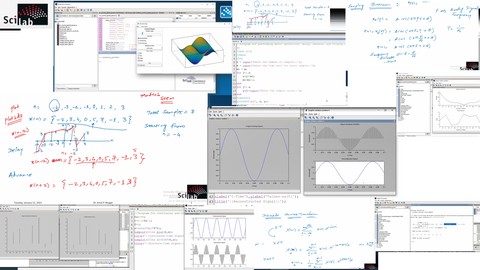
Digital Signal Processing using Scilab
Digital Signal Processing using Scilab, available at $39.99, has an average rating of 4.5, with 11 lectures, based on 2 reviews, and has 24 subscribers.
You will learn about Basic Operations on Discrete-Time Signal Verification of Sampling Theorem Scilab Implementation of Convolution, Correlation of Two Sequences, Cross Correlation, Autocorrelation, z-Transform, Pole-Zero Plot Discrete Fourier Transform, Inverse Discrete Transform, Magnitude Response, Phase Response, Circular Convolution using DFT and IDFT This course is ideal for individuals who are Beginner in Signal Processing Domain It is particularly useful for Beginner in Signal Processing Domain.
Enroll now: Digital Signal Processing using Scilab
Summary
Title: Digital Signal Processing using Scilab
Price: $39.99
Average Rating: 4.5
Number of Lectures: 11
Number of Published Lectures: 11
Number of Curriculum Items: 11
Number of Published Curriculum Objects: 11
Original Price: ₹1,799
Quality Status: approved
Status: Live
What You Will Learn
- Basic Operations on Discrete-Time Signal
- Verification of Sampling Theorem
- Scilab Implementation of Convolution, Correlation of Two Sequences, Cross Correlation, Autocorrelation, z-Transform, Pole-Zero Plot
- Discrete Fourier Transform, Inverse Discrete Transform, Magnitude Response, Phase Response, Circular Convolution using DFT and IDFT
Who Should Attend
- Beginner in Signal Processing Domain
Target Audiences
- Beginner in Signal Processing Domain
-
Scilab: Basic Operations on Discrete-Time Signal, Delay, Advance, and Folding using Scilab, Plotting Signals, Scilab Installation, Scilab Introduction
-
Scilab Implementations of Elementary Discrete-time Signals: Unit Sample, Unit Step, Unit Ramp and Exponential
-
Scilab Implementations of Graphical Representation of Continuous Signal, Discrete-Time Signal, Even and Odd Signals, Verification of whether Signal is Even or not.
-
Verification of Sampling Theorem, Sampling of Analog Signal, Sampling of Signal at Fs less than 2Fmax, Sampling of Signal at Nyquist Rate Fs=2Fmax, Sampling of Signal at Fs greater than 2Fmax
-
Scilab Implementation of Convolution with Predefined Function, conv scilab function, zero padding, Verifying output with Matrix method
-
Scilab Implementation of Convolution without Predefined Function, Conditions for Zero Padding, Identifying Response of System using Convolution Summation
-
Correlation of Two Sequences, Cross Correlation, Autocorrelation, xcorr function, Correlation using predefined function, Scilab implementation of Correlation operation.
-
Scilab code for finding z-Transform, Scilab code for demonstration of convolution property of z-transform, Defining functions in Scilab.
-
Scilab demonstration of Pole-Zero Plot, Creating Polynomials in Scilab, Numerator Polynomial, Denominator Polynomial, System Function in Scilab
-
Identifying Fourier Transform using Scilab, Signal Representation in Fourier Domain
-
Scilab Demonstrations of Discrete Fourier Transform, Inverse Discrete Transform, Magnitude Response, Phase Response, Circular Convolution using DFT and IDFT
-
Scilab Console, Writing Programs using Scilab, Implementation of basic signal processing operations
Course Curriculum
Chapter 1: Discrete-Time Signal
Lecture 1: Basic Operations on Discrete-Time Signal
Lecture 2: Elementary Discrete-time Signals
Lecture 3: Continuous Signal, Discrete-Time Signal, Even and Odd Signals
Chapter 2: Sampling Theorem
Lecture 1: Sampling Theorem, Sampling of Analog Signal
Chapter 3: Convolution of Discrete-Time Signals
Lecture 1: Convolution with Predefined Function
Lecture 2: Convolution without Predefined Function
Chapter 4: Correlation of Two Sequences
Lecture 1: Correlation of Two Sequences, Cross Correlation, Autocorrelation
Lecture 2: z-Transform, convolution property of z-transform
Lecture 3: Pole-Zero Plot
Lecture 4: Signal Representation in Fourier Domain
Lecture 5: Discrete Fourier Transform, Inverse Discrete Transform
Instructors
-
Dr Amol Prakash Bhagat
Researcher and Innovator
Rating Distribution
- 1 stars: 0 votes
- 2 stars: 0 votes
- 3 stars: 0 votes
- 4 stars: 2 votes
- 5 stars: 0 votes
Frequently Asked Questions
How long do I have access to the course materials?
You can view and review the lecture materials indefinitely, like an on-demand channel.
Can I take my courses with me wherever I go?
Definitely! If you have an internet connection, courses on Udemy are available on any device at any time. If you don’t have an internet connection, some instructors also let their students download course lectures. That’s up to the instructor though, so make sure you get on their good side!
You may also like
- Best Renewable Energy Courses to Learn in March 2025
- Best Sustainable Living Courses to Learn in March 2025
- Best Ethical AI Courses to Learn in March 2025
- Best Cybersecurity Fundamentals Courses to Learn in March 2025
- Best Smart Home Technology Courses to Learn in March 2025
- Best Holistic Health Courses to Learn in March 2025
- Best Nutrition And Diet Planning Courses to Learn in March 2025
- Best Yoga Instruction Courses to Learn in March 2025
- Best Stress Management Courses to Learn in March 2025
- Best Mindfulness Meditation Courses to Learn in March 2025
- Best Life Coaching Courses to Learn in March 2025
- Best Career Development Courses to Learn in March 2025
- Best Relationship Building Courses to Learn in March 2025
- Best Parenting Skills Courses to Learn in March 2025
- Best Home Improvement Courses to Learn in March 2025
- Best Gardening Courses to Learn in March 2025
- Best Sewing And Knitting Courses to Learn in March 2025
- Best Interior Design Courses to Learn in March 2025
- Best Writing Courses Courses to Learn in March 2025
- Best Storytelling Courses to Learn in March 2025






















